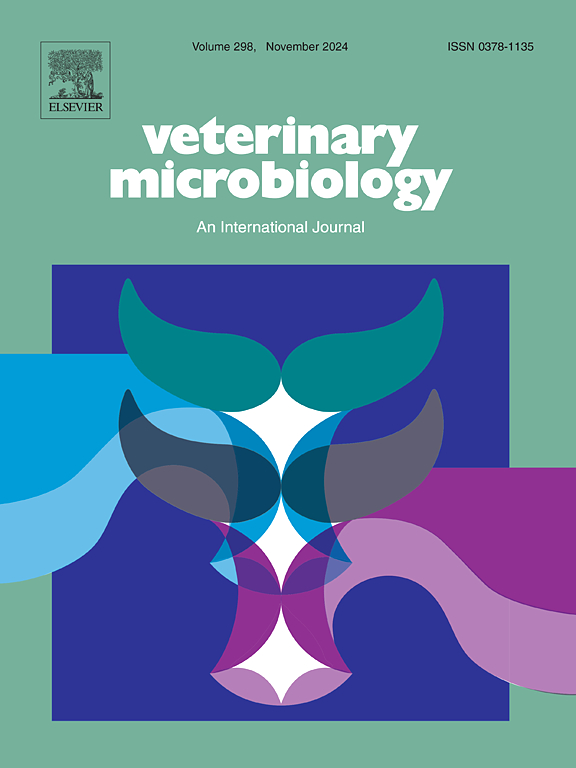Isolation of “pigeon-type” Chlamydia psittaci and detection of Chlamydia-related bacteria in Indian ring-necked parakeets (Psittacula krameri manillensis) in introduced flocks in urban area of Japan
IF 2.7
2区 农林科学
Q3 MICROBIOLOGY
引用次数: 0
Abstract
Introduced as an exotic species, Indian ring-necked parakeets (Psittacula krameri manillensis) are now established in urban areas of Japan in flocks exceeding 1000 birds. The release of exotic animals into the wild and the establishment of new populations have led to conservation and disease prevention challenges. With these parakeets sharing their habitat with humans, their feces accumulating in human living areas may pose a public health risk of transmitting Chlamydia psittaci. Herein, we investigated the prevalence of Chlamydiales in wild Indian ring-necked parakeets. We examined 66 faecal samples from wild Indian ring-necked parakeets using molecular methods and detected three samples positive for C. psittaci. The positivity rate for C. psittaci was 4.5 % (3/66) across all samples and 18.8 % (3/16) for the sampled location. Additionally, Chlamydia-related bacteria were detected. Three strains of C. psittaci were successfully isolated using HeLa cells, and the NRM_5 strain was subjected to whole-genome sequencing to determine the complete genome sequence. NRM_5 showed the highest sequence similarity to MN strain, and exhibited the sequence type is ST35, commonly associated with pigeons and doves, indicating the potential for transmission among bird species.
日本城市引进群印度环颈长尾小鹦鹉“鸽型”鹦鹉衣原体的分离及衣原体相关细菌的检测
作为外来物种引进的印度环颈鹦鹉(Psittacula krameri manillensis)现在在日本的城市地区建立了超过1000只的鸟群。外来动物被放归野外和新种群的建立给保护和疾病预防带来了挑战。由于这些长尾小鹦鹉与人类共享栖息地,它们的粪便积聚在人类生活区可能会造成传播鹦鹉热衣原体的公共卫生风险。本文调查了野生印度环颈长尾小鹦鹉中衣原体的流行情况。本文采用分子方法对66份野生印度环颈长尾小鹦鹉粪便样本进行了检测,检测出3份环颈长尾小鹦鹉粪便样本呈鹦鹉热致病菌阳性。所有样本的阳性率为4.5 %(3/66),采样地点的阳性率为18.8 %(3/16)。此外,还检测到衣原体相关细菌。利用HeLa细胞成功分离出3株鹦鹉螺,并对NRM_5菌株进行全基因组测序,确定其全基因组序列。NRM_5与MN株序列相似性最高,序列类型为ST35,常与鸽子、鸽子相关,提示有鸟类间传播的可能。
本文章由计算机程序翻译,如有差异,请以英文原文为准。
求助全文
约1分钟内获得全文
求助全文
来源期刊

Veterinary microbiology
农林科学-兽医学
CiteScore
5.90
自引率
6.10%
发文量
221
审稿时长
52 days
期刊介绍:
Veterinary Microbiology is concerned with microbial (bacterial, fungal, viral) diseases of domesticated vertebrate animals (livestock, companion animals, fur-bearing animals, game, poultry, fish) that supply food, other useful products or companionship. In addition, Microbial diseases of wild animals living in captivity, or as members of the feral fauna will also be considered if the infections are of interest because of their interrelation with humans (zoonoses) and/or domestic animals. Studies of antimicrobial resistance are also included, provided that the results represent a substantial advance in knowledge. Authors are strongly encouraged to read - prior to submission - the Editorials (''Scope or cope'' and ''Scope or cope II'') published previously in the journal. The Editors reserve the right to suggest submission to another journal for those papers which they feel would be more appropriate for consideration by that journal.
Original research papers of high quality and novelty on aspects of control, host response, molecular biology, pathogenesis, prevention, and treatment of microbial diseases of animals are published. Papers dealing primarily with immunology, epidemiology, molecular biology and antiviral or microbial agents will only be considered if they demonstrate a clear impact on a disease. Papers focusing solely on diagnostic techniques (such as another PCR protocol or ELISA) will not be published - focus should be on a microorganism and not on a particular technique. Papers only reporting microbial sequences, transcriptomics data, or proteomics data will not be considered unless the results represent a substantial advance in knowledge.
Drug trial papers will be considered if they have general application or significance. Papers on the identification of microorganisms will also be considered, but detailed taxonomic studies do not fall within the scope of the journal. Case reports will not be published, unless they have general application or contain novel aspects. Papers of geographically limited interest, which repeat what had been established elsewhere will not be considered. The readership of the journal is global.
 求助内容:
求助内容: 应助结果提醒方式:
应助结果提醒方式:


